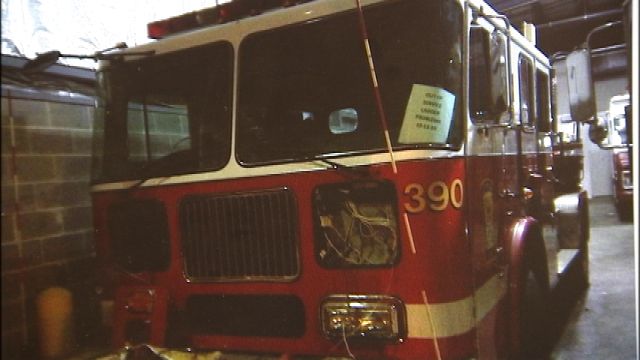DC’s EMS woes puts spotlight on the regeneration gap. Shop chief says ambulance shut down apparently came with little warning.
DC Breaking Local News Weather Sports FOX 5 WTTG
Click here to follow STATter911.com on Facebook (hit “like”)
Previous coverage
Three-years-ago Boca Raton (FL) Fire Chief Tom Wood contacted me about what was, at that point, a little discussed but potentially major issue facing fire and EMS across the country. Admittedly, my eyes glazed over a bit as Chief Wood explained the ins and outs of the new EPA mandated diesel emission standards. But my news instincts kicked in when the chief told me about his ambulances shutting down on major highways and limping back to quarters. That’s what brought about the guest column in April of 2010 titled The Regeneration Gap: A fire chief wrestles with front-line apparatus time-outs due to EPA diesel emission regulations.
The issue has not gone away, even though EPA made some modifications to the regulations that, on the surface, were supposed to help fire and EMS deal with the problem (though most say it really didn’t). Wednesday’s shut down of a DC Fire & EMS Department ambulance on I-295 while transporting a trauma code shooting victim to the hospital has the mainstream media’s attention on regeneration, for the moment. The Washington Post’s Mike DeBonis linked to Chief Wood’s 2010 column online and reporter Peter Hermann interviewed him for an article in today’s paper.
In the DC case, the early word from union president Ed Smith, and shop head, Deputy Chief John Donnelly, is that the normal warnings didn’t happen with Ambulance 19. Here’s what Peter Hermann wrote:
A warning light is supposed to flash and give the driver enough time to complete an emergency run before taking a scheduled break. Donnelly said that didn’t happen Wednesday; instead, a more severe indicator came on warning of imminent failure.
“That is not supposed to happen,” the deputy chief said, noting that he was awaiting results of a diagnostic test to determine whether the breakdown was the result of a clogged filter or some other problem.
Chief Wood doesn’t know the details of the DC incident but he has made it his business to come up with solutions for his department, including doing forced regeneration on a schedule rather than being at the mercy of the rig. Here’s what he wrote in our comments section yesterday:
Your readers may be interested in an article I wrote in our Department Newsletter in July-August 2012. The link is here: http://myboca.us/fire/pdf/Newsletters/July-August2012.pdf
The article highlights an incident in Bracketville, Texas from February 15, 2012 in which the passenger of a truck fire died. “Diesel motor de-rating” slowed the fire apparatus response to the scene.
Regeneration can be performed on demand or “forced regeneration” by a qualified mechanic and the correct software. Our fleet has three different motor manufacturers and our shop has the software to “force regeneration” on our schedule, instead of at random. We schedule our fleet through the shop once a month for “forced regeneration”, one unit at a time. This also assures a complete 100% cleaning of the Diesel Particulate Filter (DPF). Under the random / ordinary method, many of our apparatus were regenerating every 4 days, obviously not completing the process. I recommend the “forced regeneration” as a best practice.
Below is more coverage of the DC incident.
Peter Hermann, The Washington Post:
“I know they’re trying to reduce pollution emissions, but I don’t know if they contemplated all the dangers,” said Thomas R. Wood, the chief of fire rescue services in Boca Raton, Fla. “Fire doesn’t take a timeout to let firefighters regroup and regenerate.”
Last year, the EPA, facing criticism from fire chiefs and trade groups, allowed for exceptions so that emergency vehicles “would no longer face power disruptions.”
But Harold Boer, head of the Fire Apparatus Manufacturing Association, said the waiver does not fully exempt emergency vehicles and instead allows them to be retrofitted so there is more time between regeneration stops. Boer, who is also president of the fire truck builder Rosenbauer, said few cities request the work because it does not eliminate the problem. He said a request to the EPA for a blanket exemption for all emergency vehicles has been denied.
D.C. fire department officials are still probing the glitch, but they said the issue seems to be specific to a sequence of warning lights that ultimately notify the ambulance crew the engine will shut off imminently. And while it’s the first time city officials said a department ambulance has failed while in transport as a result of the emissions system, widespread problems have been reported nationally.
“What I want to do is see what the computer says about this problem, and then we can re-evaluate if we need to do anything,” Deputy Chief John Donnelly said, assessing the extent of the issue. “We’re going to look at the series of warning lights and the indicators. They should lead us back to the problem.”
When the D.C. fire department began buying these diesel engine ambulances a few years ago, officials knew they would have to manage them with a new emission control system that would automatically shut the engine down if it wasn’t allowed to what’s called “regenerate.”
It was a mandate from the Environmental Protection Agency.
And until recently, the fire department said it had been able to handle the requirements without any significant incidents.
One of those incidents involved the same ambulance that broke down Wednesday.
“On May 22nd or 23rd, it was here in the shop,” said Deputy Chief John Donnelly of D.C. Fire and EMS. “It had a problem with the regeneration system. That problem was a lot different. The end result is the same – the engine gave a warning light. But it was different in some ways and we sent it to the dealer and got it back. It was repaired and it was running fine when we put it back in service.”
Donnelly says the drivers of the rigs and the people who manage them have to stay on top of the warning lights to make sure they don’t ever approach the shut down level.
“We don’t want to have any incidents like this, but we’ve shown we can manage it,” he said. “It’s tough. It takes a lot of coordination and effort and there are a number of people that work on it. The drivers have a role, the dispatchers have a role, the battalion chiefs and EMS supervisors have a role and everybody has been doing their job in managing this. I’m confident we can.”
Do you want to sell a rig? Click HERE to find out how with SellFireTrucks.com.






